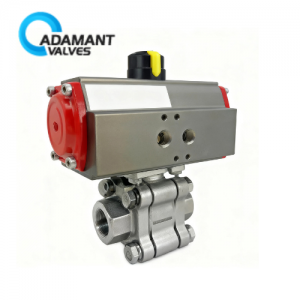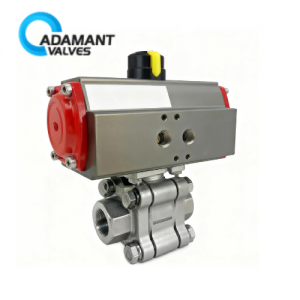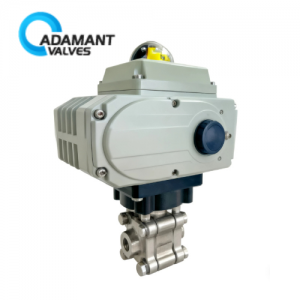Your Complete Guide to Ball Valves
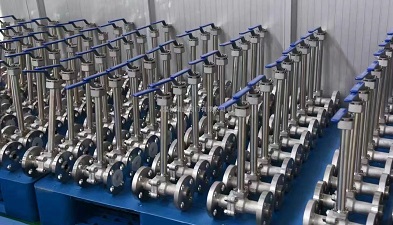
Like most mechanical parts that keep our lives running smoothly, most people don’t know what a ball valve is until they run into a problem with one. But ball valves are quietly and efficiently doing their job in almost every aspect of American life.
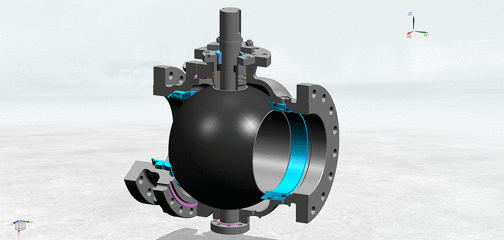
Actuation method of ball valves
Ball valves are used in manufacturing, the food industry, health care operations, and many appliances found in homes. These valves are used to keep liquids and gases flowing in the right direction, many without the need for sophisticated technology.
This guide will provide detailed information about a variety of ball valves and their uses, including how they work and what purposes they serve.
What Is a Ball Valve?
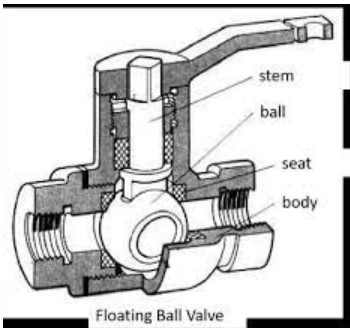
Ball Valve Diagram
A ball valve is a type of shut-off valve. It consists of a ball that has had a borehole drilled through the center and a handle. You use the handle to rotate the ball up to 90 degrees, which allows liquid or gas to flow through the borehole. When the valve is in the closed position, the solid part of the ball effectively creates a seal, keeping whatever is in the pipe trapped behind it.
Versatile and long-lasting ball valves can be made of many different materials and come in a variety of sizes. Their simple design means that you can easily have them custom-fitted. The main limiting factor for a ball valve is the specific application you need it for. A PVC ball valve may work just fine for low pressure and low-temperature applications, but you may need a stainless steel ball valve to stop the flow of materials that are at high temperatures or under a great deal of pressure.
Not all ball valves are manually operated. Some, like the electric ball valve, open and close when electrical current is passed through them. These motorized ball valves are used in high-pressure applications where the ball valve is open and closed frequently and continuously.
How does a ball valve work?
The basic concept of a ball valve is simple. A ball that matches the shape and size of the pipe is fitted into the valve. This ball has a bore hole that runs through its core and a handle or gear that moves it on its axis.
In the closed position, the solid part of the ball seals the valve shut. When rotated, the contents of the pipe flow through the valve until it is returned to its closed position. At a 90-degree rotation, the entire borehole is exposed, allowing for the full flow of the pipe’s contents. The flow can be controlled by partially rotating the ball valve handle.
Ball check valves work on the same principles as other ball valves except that they have a means, usually a flap or disk, of preventing backflow. This type of ball valve shuts off flow when the pressure decreases. When opened, the pressure of the medium flowing through the pipe pushes the disk or flap out of the way. When the pressure flowing forward decreases, the flap or disk falls back into place to keep the contents of the pipe from flowing backward. This happens regardless of whether the ball valve is open or closed.

What does a ball valve do?
A ball valve is a shut off valve. It is used to start and stop the flow of liquids or gases through a pipe or other confined space. Water ball valves can be found in almost any home or business with running water.
Do ball valves control pressure?
You can use ball valves to control the pressure in a pipeline or other confined space. By only opening the ball valve partially, you can control how much of the pipe’s contents flow through it. If you open it slightly, the amount flowing will be small and move at lower pressure. If you open the valve fully, both the flow and the pressure will be higher.
Traditional sink taps use ball valves to control the flow of water. By adjusting the taps, you move a ball valve and control how much water comes out of the tap.
Your Quick Guide to Ball Valve Markings
Ball valve markings are labels or tags placed on the pipe that houses the valve. They provide vital information for anyone who needs to perform maintenance on the valve or the pipe that contains it.
The coded information on these labels or tags tells you many things, including information about the valve itself, the type of medium flowing through it, the pressure that contents are likely to be under, the temperature of the medium, and whether or not the contents are flammable or in another way dangerous.
This labeling system, set by the American National Standards Institute (ANSI), is vital to the health and safety of those working on the pipes. It also ensures that those who do the work are prepared with the correct gear and tools before the job begins.
ANSI is one of the three organizations that regulate the labeling, use, and maintenance standards for ball valves.
- ANSI. This organization is responsible for setting voluntary safety standards for many industries in the United States, including the manufacture and use of ball valves. They created the labeling standards for valves and work to ensure that these standards are met.
- Uniform Plumbing Code (UPC). Set by the International Association of Plumbing and Mechanical Officials (IAPMO), this code was created to ensure the safety of both plumbers and consumers through a consistent and regulated code of conduct. The UPC includes the requirements that pipe and valve labels follow the ANSI standards.
- Underwriters Laboratories (UL). This is a global nonprofit organization devoted to promoting safe practices in industries around the world. In addition, this organization is responsible for testing the proper functioning of many of the mechanical parts, including ball valves, that all industries rely on to function.
Common ball valve sizes
Although ball valves can be custom made to fit any application, there are standard sizes designed to fit most needs. The most commonly used sizes are:
- 2 inch ball valve
- 1 inch ball valve
- ¾ ball valve
- ½ ball valve
- ⅜ ball valve
- ¼ ball valve
Each of these sizes serves a specific purpose, from bathroom sinks to garden hoses to boiler steam pipes. The size of the ball valve should be listed in the valve label or tag.
There are some other important pieces of information that you can find on valve labels.
PN: Pressure Nominal Classes
The PN Class number lets you know how much pressure the valve is designed to withstand. The PN is designated by bars, with each bar representing 14.5038 pounds of pressure. This means that a valve label with 3 bars would indicate that the underlying valve could withstand pressures of up to 43.5114 pounds.
PSI Rating
PSI stands for pounds per square inch and is a standard measurement for pressure in any circumstance. When listed on a valve tag or label, it indicates the pressure of the liquid or gas that is flowing through the pipe. The higher the PSI rating, the more durable the ball valve must be to withstand the force applied against it.
What does CWP mean on a ball valve?
CWP stands for cold working pressure. This value on a valve label or tag is used to indicate the maximum pressure the valve can withstand at temperatures between –20 degrees and 100 degrees Fahrenheit. This temperature range is considered to be the cold range. For example, a 680 CWP would mean that the labeled valve can withstand 680 PSI at temperatures within the cold range.
This means that you can count on a ball valve with a high CWP to perform well at the lower temperatures found in dairies, food processing plants, and anywhere else that cold media is traveling through the valve.
What does SWP mean on a ball valve?
SWP stands for steam working pressure. It may also be labeled WSP for working steam pressure. Either way, it means the same thing. It indicates the pressure the valve will continue to function at even in the highest temperature range.
Ball valves with a high SWP are essential for pipes that carry steam, lubricants for engines, and hydraulic systems where friction may heat the oil. They have many industrial uses.
The 10 Most Important Types of Ball Valves
Ball valves are simple to repair and replace, long lasting, and highly effective. Because of these advantages, we use them in almost every home, business, and manufacturing plant. Anywhere you find pipes, you will find ball valves controlling the flow of the medium inside of them.
How many types of ball valves are there?
Over time, many types of ball valves have been developed to meet specific needs. In the following list, you will find the 10 most important types of ball valves and some of their common uses.
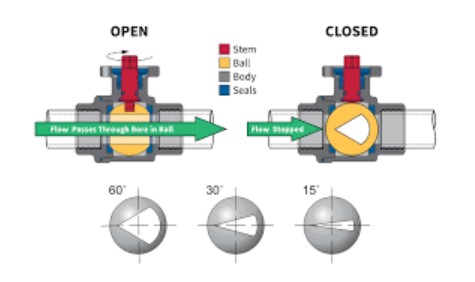
V-Port Ball valve Diagram
1. Sanitary Ball Valve
These valves are designed for use in the food industry, pharmaceutical manufacturing, and anywhere that sterilization is required. They come in many different configurations and sizes and may be manual, mechanical, or electric actuated ball valves. They all share the ability to be sterilized by heat or chemicals, and they have smooth, polished surfaces to prevent the build-up of debris.
2. V-Port Ball Valves
Unlike most ball valves, the V-port ball valve does not have a ball with a bore hole but rather a floating ball that is compressed when the valve is open. When the valve is closed, the ball expands and blocks both the in and out ports of the valve. This feature creates a tighter seal.
3. Full Port Ball Valve
A full port ball valve has a borehole with the same diameter as the pipe leading to the valve. When fully opened, this type of ball valve allows for the free flow of the pipe’s contents without bottlenecking in the valves. These valves are most often found in situations where the medium in the pipes must flow at a steady pace or when high-pressure ball valves are used.
4. Multi-Port Ball Valve
These valves may be 3-way ball valves or have more connectors that allow the flow of the medium to be diverted in different directions as needed. They can be made so that the flow travels in only one direction at a time or designed so that multiple connectors can be opened simultaneously.
5. Standard Port Ball Valve
The bore holes on standard port ball valves have a smaller diameter than the pipes leading into them. They are usually less expensive and more durable than full bore ball valves, but they will restrict the flow of the pipe’s contents even when they are fully opened.
6. Reduced Port Ball Valve
Reduced port ball valve is another name for the standard port ball valve, which is explained in number 5.
7. True Union Ball Valve
These ball valves have double unions with the pipes that contain them. The unions can be sealed at either end of the valve, which allows you to completely remove them for repair or replacement.
8. Manually Operated Ball Valve
Many different configurations of ball valves may fall into this category. As the name implies, you manually control these valves using a handle mounted outside of the pipe.
9. Electric Ball Valves
Electric ball valves are opened and closed by an electrical current instead of a handle.
10. Motorized Ball Valves
These valves are electric ball valves. They use an electrically powered motor mounted over the valve that opens and closes it as needed. Motorized ball valves are commonly found in automated factories and manufacturing plants.
Conclusion — Who Makes Quality Ball Valves?
Regardless of the application, your best chance of long-term success is to get your valves from a respected and reliable source. There are many ball valve manufacturers, but few offer the quality, variety, and customer satisfaction levels of Adamant Valves.
Since 2002, Adamant Valves has been working to improve ball valve design, manufacturing, and materials to create reliable, long-lasting, and economical choices. Adamant Valves manufactures a large range of sizes and can supply you with a custom fit if a standard size does not work. Adamant Valves has quickly gained a reputation for high-quality valves delivered quickly and has become a leading supplier of valves to food manufacturing and distribution plants, cosmetics manufacturers, pharmaceutical companies, and many other industries.
To find out how Adamant Valves can meet your ball valve needs, contact us today.


